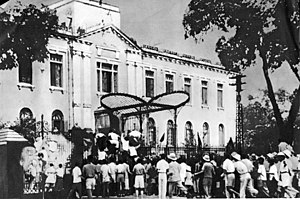
Back ثورة أغسطس Arabic Avqust inqilabı Azerbaijani August-revolutionen Danish Augustrevolution German Aŭgusta Revolucio Esperanto Revolución de agosto Spanish انقلاب آگوست Persian Révolution d'Août French Օգոստոսյան հեղափոխություն Վիետնամում Armenian Revolusi Agustus ID
The August Revolution (Vietnamese: Cách-mạng tháng Tám), also known as the August General Uprising (Vietnamese: Tổng khởi-nghĩa giành chính-quyền tháng Tám, lit. 'the Total uprising to seize power in August'), was a revolution led by the Việt Minh against the Empire of Vietnam from 16 August to 2 September 1945. The Empire of Vietnam was led by the Nguyễn dynasty and was a puppet state of Japan within the Greater East Asia Co-Prosperity Sphere.[3] The Việt Minh, a political league de facto led by the Communist Party, was created in 1941 and designed to appeal to a wider population than what the communists could command. The Việt Minh was supported by the US.[4] The revolution had the participation of factions that did not follow the Việt Minh.
The Japanese army in Vietnam did nothing to prevent the revolution as they de facto surrendered to the Allies and World War II ended. There was only a sporadic clash in Thái Nguyên with inconclusiveness. Japan still recognized its puppet as the legitimate government of Vietnam but the Empire of Vietnam refused Japan's request for help because its prime minister did not want foreign army to suppress the Việt Minh when he supported Vietnamese nationalism and did not discover their communist nature, leading to the revolution happening peacefully.[5][6] During and after the revolution, the communist Việt Minh had seized control of most of Vietnam, the rest was in the hands of non-communist faction. The Nguyễn dynasty with its puppet government of Trần Trọng Kim collapsed when its emperor Bảo Đại abdicated on 25 August 1945. He was later accepted as an advisor to the government of the Việt Minh and was "elected" a member of its National Assembly, but was later abandoned in China by the communists. The August Revolution sought to create a unified and independent state for Vietnam under the Việt Minh's rule. Việt Minh leader Hồ Chí Minh declared the establishment of the Democratic Republic of Vietnam (DRV) to replace the old Nguyễn dynasty on 2 September 1945, but this government was not recognized as an independent state by French colonialists. No country recognized the DRV while French sovereignty over Indochina was recognized by the Allies. The Việt Minh used its non-communist cover to successfully attract many non-communist nationalists, but there were many other non-communist nationalists who did not accept communist rule. The foundation of the DRV was the first time Vietnam became a republic. However, the return of France and communist monopoly led to the purges of non-communist dissidents and the formation of a rival state of ex-emperor Bảo Đại in 1949 as part of decolonization, a pro-French and anti-communist regime.[7]
- ^ Political parties conflicts in Democratic Republic of Vietnam (North Vietnam)
- ^ "Vo Nguyen Giap | Biography & Vietnam War | Britannica". www.britannica.com. Archived from the original on 2 June 2022. Retrieved 30 July 2023.
- ^ Tiến sĩ Lê Mạnh Hùng (15 April 2006). "Chính phủ Trần Trọng Kim năm 1945". Đài Á Châu Tự do. Retrieved 27 August 2013.
- ^ Berube, Claude (24 May 2011). "Ho, Giap and OSS Agent Henry Prunier". HistoryNet.
{{cite web}}: CS1 maint: url-status (link) - ^ Bob Bergin (June 2018). "Studies in Intelligence Vol. 62, No. 2 (Extracts, June 2018) – Old Man Ho – The OSS Role in Ho Chi Minh's Rise to Political Power" (PDF). Central Intelligence Agency (CIA) – Government of the United States. Archived from the original (PDF) on 28 May 2023. Retrieved 7 September 2022.
- ^ Một cơn gió bụi, chương 4 Archived 2014-10-19 at the Wayback Machine
- ^ Igarashi, Masahiro (2002). Associated Statehood in International Law. The Hague, Netherlands: Kluwer Law International. p. 24. ISBN 90-411-1710-5.
